Following an invigorating five days of sightseeing, wine-tasting, and restaurant-hopping in South Africa, we boarded the Azamara Journey, embarking upon 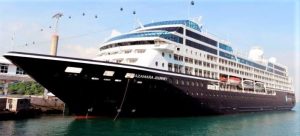 a somewhat unusual odyssey, a 21-day cruise that would transport us up the west coast of Africa, making port in several third-world countries, the Canary Islands, and Madeira Island, Portugal, before eventually disembarking in Lisbon.
a somewhat unusual odyssey, a 21-day cruise that would transport us up the west coast of Africa, making port in several third-world countries, the Canary Islands, and Madeira Island, Portugal, before eventually disembarking in Lisbon.
Lisbon, Portugal: Following a day at sea, we disembarked in Lisbon at 8:00 a.m., where a bus was waiting to take us on our final excursion. This was the second cruise in which Lisbon had been our last port-of-call. During the previous visit, we toured the city by Tuk Tuk, an open-air three-wheeled electric vehicle similar to a golf cart. A great way to see the city; and we had an excellent guide. Unfortunately, the Tuk Tuk was extremely uncomfortable, especially since we were seated backwards, and leg room was almost nonexistent. This excursion – on a comfortable, air-conditioned bus – was a good deal more civilized, and also included a host of sights not previously visited.
Our first stop was the Church of Santa Maria de Belém, which, together with the adjoining Jerónimos Monastery, are the finest examples of 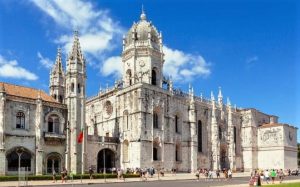 Portuguese Manueline architecture. Also known as Portuguese late Gothic, it is a sumptuous architectural style originating in the 16th century defined by the use of lavish, themed ornamentation… doorways, columns, and windows encrusted in opulently carved stonework.
Portuguese Manueline architecture. Also known as Portuguese late Gothic, it is a sumptuous architectural style originating in the 16th century defined by the use of lavish, themed ornamentation… doorways, columns, and windows encrusted in opulently carved stonework.
Within the church, located in the lower choir, are the stone tombs of Vasco da Gama (1468 – 1523) and the great poet and chronicler of the Age of Discoveries, Luis Vaz de Camöes (1527 – 1580). Both tombs were sculpted by the 19th century sculptor Costa Mota in a neo-Manueline style. The remains of both were transferred to these tombs in 1880. Vasco da Gama, 1st Count of Vidigueira, was a Portuguese explorer and the first European to reach India by sea. Luis Vaz de Camöes is considered Portugal’s and the Portuguese language’s greatest poet. His mastery of verse has been compared to that of Shakespeare, Milton, Vondel, Homer, Virgil, and Dante. The date of his death, June 10th, is Portugal’s National Day.
It was late on Saturday morning when our bus arrived at the church and parked next to a small park across the street. Just one little problem. There were two 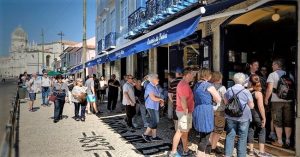 lines: one to enter the sanctuary; the other to enter the cloister… and both were formidable. The thought of standing in line for a good hour was not a particularly attractive one… Especially since I knew from our previous visit that we were a scant block away from Pastéis de Belém, Lisbon’s iconic café/bakery specializing in Pastéis de Nata, Portugal’s famous custard tarts (that were, by the way, originally created by Catholic monks in the above-mentioned Jerónimos Monastery sometime just prior to the 18th century). And since we’d been up since the crack of dawn and had not had time for breakfast, the Pastéis was looking better and better. And once our guide actually mentioned the bakery by name and then gave our entire party free rein for an hour and a half, it was a done deal.
lines: one to enter the sanctuary; the other to enter the cloister… and both were formidable. The thought of standing in line for a good hour was not a particularly attractive one… Especially since I knew from our previous visit that we were a scant block away from Pastéis de Belém, Lisbon’s iconic café/bakery specializing in Pastéis de Nata, Portugal’s famous custard tarts (that were, by the way, originally created by Catholic monks in the above-mentioned Jerónimos Monastery sometime just prior to the 18th century). And since we’d been up since the crack of dawn and had not had time for breakfast, the Pastéis was looking better and better. And once our guide actually mentioned the bakery by name and then gave our entire party free rein for an hour and a half, it was a done deal.
As you can tell from the photo above, the bakery is exceedingly popular. Fortunately, there is a separate (and less crowded) entrance to their dining room.  And, as noted above, the Pastéis de Nata, those incredible Portuguese custard tarts, are the specialty of the house. They are crunchy and creamy but, thankfully, not too eggy – and downright addictive. There are a number of menu possibilities… You may, for example, enjoy your Pastel de Nata with a glass of port (or wine or beer), if you so desire. But, for my money, coffee is the ideal companion (espresso is even better). The combo is incomparably tasty. And, trust me, it is difficult (if not impossible) to eat just one.
And, as noted above, the Pastéis de Nata, those incredible Portuguese custard tarts, are the specialty of the house. They are crunchy and creamy but, thankfully, not too eggy – and downright addictive. There are a number of menu possibilities… You may, for example, enjoy your Pastel de Nata with a glass of port (or wine or beer), if you so desire. But, for my money, coffee is the ideal companion (espresso is even better). The combo is incomparably tasty. And, trust me, it is difficult (if not impossible) to eat just one.
Following this most enjoyable repast, we were off to the next point of interest… The Torre de Belém (Belém 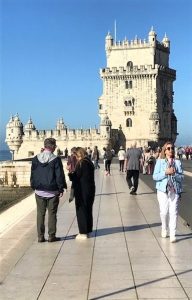 Tower), officially the Tower of Saint Vincent, is a 16th century fortification that served as a point of embarkation and disembarkation for Portuguese explorers and as a ceremonial gateway to Lisbon. It was built during the height of the Portuguese Renaissance and is a prominent example of the Portuguese Manueline style, although it incorporates hints of other architectural features. Constructed of ioz limestone (limestone originating in the Lisbon region of Portugal) it is composed of a bastion and four-story tower.
Tower), officially the Tower of Saint Vincent, is a 16th century fortification that served as a point of embarkation and disembarkation for Portuguese explorers and as a ceremonial gateway to Lisbon. It was built during the height of the Portuguese Renaissance and is a prominent example of the Portuguese Manueline style, although it incorporates hints of other architectural features. Constructed of ioz limestone (limestone originating in the Lisbon region of Portugal) it is composed of a bastion and four-story tower.
Since 1983, the tower has been a UNESCO World Heritage Site (along with the aforementioned Jerónimos Monastery). It is often portrayed as a symbol of Europe’s Age of Discovery and as a metonymy (the substitution of the name of an attribute or adjunct for that of the thing meant) for Portugal or Lisbon, given its landmark status.
Padräo dos Descobrimentos, Monument of the Discoveries, is a monument on the northern bank of the Tagus River estuary where ships departed to explore and trade with India and the Orient. It celebrates the Portuguese Age of Discovery during the 15th and 16th centuries.
The monument was conceived in 1939 by Portuguese architect José Ângelo Cottinelli Telmo and sculptor Leopoldo de Almeida. It was designed as a 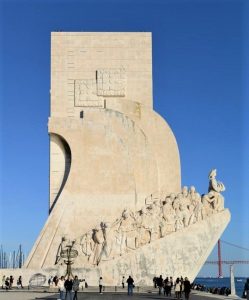 temporary construction during the Portuguese World Exhibition opening in June 1940. It was demolished in June 1943. Between November 1958 and January 1960, the new monument was constructed in cement and rose-tinted stone, and the statues sculpted from limestone excavated from the region of Sintra. Located on the northern bank of the Tagus River, the new project was enlarged from the original 1940 model as part of the commemorations to celebrate the fifth centennial of the death of Henry the Navigator.
temporary construction during the Portuguese World Exhibition opening in June 1940. It was demolished in June 1943. Between November 1958 and January 1960, the new monument was constructed in cement and rose-tinted stone, and the statues sculpted from limestone excavated from the region of Sintra. Located on the northern bank of the Tagus River, the new project was enlarged from the original 1940 model as part of the commemorations to celebrate the fifth centennial of the death of Henry the Navigator.
The 171-feet high slab stands vertically along the bank of the Tagus, with the design taking the form of the prow of a caravel (ship used in early Portuguese exploration). On either side of the slab are ramps that join at the river’s edge, with the figure of Henry the Navigator on its edge. On each side are 16 figures (33 in total) representing figures – monarchs, explorers, cartographers, artists, scientists, and missionaries – from the Portuguese Age of Discovery.
The top of the monument, reached via an elevator or stairs, offers a view of the Tagus River, the Belém Tower and its neighborhood, and the Jerónimos Monastery.
Gago Coutinho was an early Portuguese aviation pioneer who, along with Sacadura Cabral, were the first pilots to fly 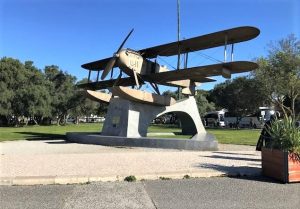 across the South Atlantic Ocean. The flight of 5,220 miles departed Lisbon on March 24, 1922, and arrived in Rio de Janeiro 79 days later on June 6, 1922.
across the South Atlantic Ocean. The flight of 5,220 miles departed Lisbon on March 24, 1922, and arrived in Rio de Janeiro 79 days later on June 6, 1922.
In the park near the Belém Tower, is a monument erected in honor of that first air flight across the South Atlantic, an exact replica of Coutinho’s Fairey Seaplane, the Santa Cruz. And the location is quite fitting, as it was from this stretch of parkland that the plane originally took off on March 24, 1922.
Our final stop of the day was the Corinthia Lisbon Hotel, where we were booked in for one night prior to 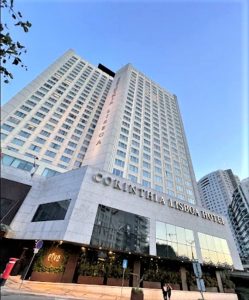 catching our morning flight back to the U.S. Despite the fact that this luxurious high-rise was praised by reviewers – 4.5 out of 5 ratings by TripAdvisor and Fodor’s, both of whom noted its popularity with the business/leisure traveling crowd – I would have preferred something a bit less modernistically generic. However, since this had been arranged through the cruise line, there was really no choice.
catching our morning flight back to the U.S. Despite the fact that this luxurious high-rise was praised by reviewers – 4.5 out of 5 ratings by TripAdvisor and Fodor’s, both of whom noted its popularity with the business/leisure traveling crowd – I would have preferred something a bit less modernistically generic. However, since this had been arranged through the cruise line, there was really no choice.
On the positive side, our room was quite spacious and afforded a great view out over the city. The hotel also boasted a host of other amenities – the largest luxury hotel SPA in Portugal, offering 13 treatment rooms and a wide range of spa services; an indoor lap pool and adjoining sun terrace; a water therapy circuit and fully equipped fitness center with trainers and physiotherapists; for those booking suites, the exclusive Sky Lounge with access to more private facilities that feature all-day snacks and beverages, concierge services and, 24th-floor views over the city – all of which, because of our abbreviated stay, we were unable to take advantage of.
We were, however, looking forward to dinner at the hotel’s equally highly-touted – on OpenTable, Yelp, and 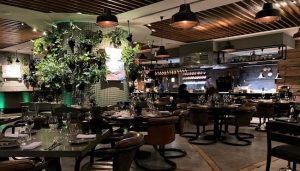 TripAdvisor – Erva Restaurante & Bar, where Chef Carlos Goncalves, previously at Lisbon’s Ritz Four Seasons, was now holding forth as the power behind the stove. Tucked away on the hotel’s ground floor, Erva certainly looked the part… walls alive with vertical gardens of leafy plants, rustic wood dining tables, leather vintage-style chairs, a semi-open kitchen and, in the evening, subdued lighting casting a romantic aura over the enticingly informal setting.
TripAdvisor – Erva Restaurante & Bar, where Chef Carlos Goncalves, previously at Lisbon’s Ritz Four Seasons, was now holding forth as the power behind the stove. Tucked away on the hotel’s ground floor, Erva certainly looked the part… walls alive with vertical gardens of leafy plants, rustic wood dining tables, leather vintage-style chairs, a semi-open kitchen and, in the evening, subdued lighting casting a romantic aura over the enticingly informal setting.
But, alas… Erva proved a major disappointment. For starters, our server was a bit off the wall…and loquacious to a fault. The moment he arrived at our table he went into his well-rehearsed spiel about daily specials – then abruptly disappeared before we could order cocktails… He reappeared with a variety of breads, butters & dipping sauces – and promptly vanished once again… We finally caught his eye, called him over, and told him we wished to order cocktails. He seemed surprised… Well, you get the idea. We just never quite connected with this guy; he just seemed to be operating in some strange parallel universe. Downright obsequious at the outset, as the evening progressed, his attention waned to such an extent that we had to send out a search party to secure the check.
The It Came from Outer Space service notwithstanding, we still had high hopes for the cuisine, as our shared appetizer of Mushrooms in Red Wine certainly  started things off on a positive note… From there, however, it was downhill. The Baked Sole for Two, filleted tableside, sounded simply wonderful. Unfortunately, the person called upon to perform this delicate operation was not terribly adept. The sole itself was in desperate need of seasoning; and not even the bland-leading-the-bland butter sauce could snatch victory from the jaws of defeat. Anything even approximating flavor was strictly coincidental (pictured: Sole, ready for surgery).
started things off on a positive note… From there, however, it was downhill. The Baked Sole for Two, filleted tableside, sounded simply wonderful. Unfortunately, the person called upon to perform this delicate operation was not terribly adept. The sole itself was in desperate need of seasoning; and not even the bland-leading-the-bland butter sauce could snatch victory from the jaws of defeat. Anything even approximating flavor was strictly coincidental (pictured: Sole, ready for surgery).
Then there were the side dishes. While the Sweet Potato Purée was quite good, the Grilled Vegetables were strictly pedestrian… Desserts? Eminently forgettable.
The Bottom Line: Erva was an extremely disappointing conclusion to an otherwise enjoyable and enlightening journey.
Bon Appétit & Cheers!
TAD

{ 0 comments… add one now }